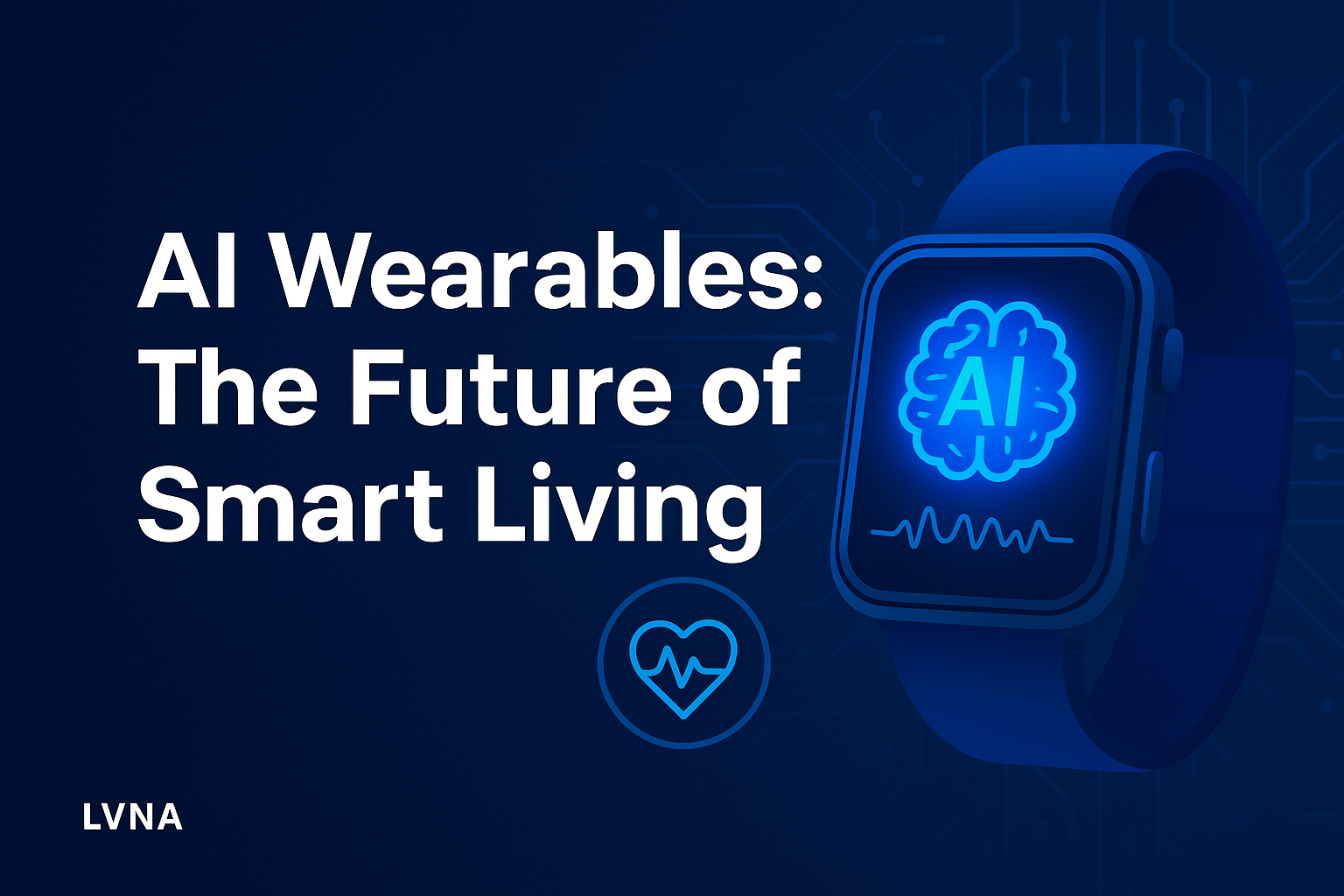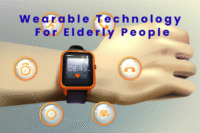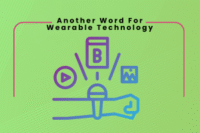AI Wearables: The Future of Smart Living
Published: 08 Aug 2025
AI wearables combine artificial intelligence with smart devices to make daily life easier, healthier, and more connected. They help track health, improve productivity, and bring smarter living to everyone.
What Are AI Wearables? AI wearables are not just gadgets you strap onto your body—they’re intelligent assistants seamlessly integrated into your daily routine. Think of them as tiny computers that learn from your habits, monitor your health, and even anticipate your needs. Unlike standard wearables that simply count steps or display notifications, wearable AI devices analyze massive amounts of data in real time and provide insights that actually improve decision-making.

For example, a smartwatch doesn’t just measure your heart rate anymore; with AI in wearable technology, it can detect irregular heartbeats and warn you about potential risks before they escalate. Similarly, earbuds are no longer just about music; AI can tune sound frequencies to protect your hearing or translate languages on the go. This shift from “basic tracking” to “smart prediction” is what truly defines ai wearables.
Imagine having a personal coach, medical assistant, and lifestyle manager—all in one device strapped to your wrist or embedded in your clothing. That’s the power of wearable AI, and it’s why they’re taking the tech world by storm.
Evolution of Wearable Technology
The story of wearables started decades ago, but it wasn’t until the early 2010s that they began to take shape as consumer products. The first wave of wearables was basic—step counters, calorie trackers, and watches that could sync with your phone. These early devices were useful but limited. They could show you what you did, but not what you should do next.
AI in wearable technology completely flipped that script. Instead of wearables being passive tools, they became proactive companions. For instance, early fitness trackers could tell you that you slept six hours. Today’s ai wearables go further: they analyze your sleep cycles, recommend optimal bedtimes, and even suggest foods or activities to improve sleep quality.
The evolution has also been influenced by advancements in sensors, machine learning, and cloud computing. Smaller sensors now capture more accurate data, while AI algorithms process that data into meaningful insights. In short, wearable AI has evolved from simple gadgets into intelligent ecosystems designed to improve both physical and mental well-being. To know more about wearable history.
Why AI is the Game-Changer in Wearables
Without AI, wearables would still be glorified calculators. The real magic lies in AI’s ability to recognize patterns and predict outcomes. That means your wearable AI devices don’t just know what’s happening—they can forecast what will happen.
Take health monitoring as an example. A standard tracker might show a heart rate spike, but AI goes deeper. It compares the spike to your historical data, considers your activity level, and decides whether it’s normal or a cause for concern. This predictive capability can save lives by detecting conditions like atrial fibrillation or sleep apnea before they become dangerous.
Beyond health, AI is also revolutionizing user experience. Imagine earbuds that know which environment you’re in—whether a noisy street, quiet library, or airplane cabin—and automatically adjust sound settings. Or smart glasses that recognize objects around you and provide contextual information in real time.
Ai wearables are not just about adding convenience; they’re about empowering humans to live smarter, safer, and healthier lives. That’s why experts call them the “brain” behind wearable AI technology.
Types of AI Wearables
Types of AI Wearables include smartwatches, fitness trackers, smart glasses, and earbuds. These ai wearables use AI to track health, improve daily tasks, and make life easier.
Smartwatches and Fitness Trackers
Smartwatches and fitness trackers are the most popular form of ai wearables, and for good reason. They combine convenience, health monitoring, and productivity into a sleek device worn on the wrist. But with AI, they’ve gone far beyond counting steps and sending text notifications.
The best AI wearables in this category now offer advanced features like ECG monitoring, blood oxygen measurement, stress detection, and even hydration tracking. They use machine learning algorithms to detect anomalies in your health patterns, making them a powerful tool for early diagnosis. Some models can even predict the onset of a migraine or alert you if your body shows early signs of illness.
On the fitness side, wearable AI transforms basic activity tracking into personalized coaching. Instead of simply telling you how many calories you burned, your wearable might analyze your workout efficiency, recovery time, and long-term progress. It can then suggest new exercises or training schedules tailored to your body’s specific needs.
The integration with smartphones, apps, and even smart home systems makes smartwatches more than just wearable AI devices—they’re mini command centers for your daily life.
How AI Enhances Health Monitoring
AI is the backbone of modern health wearables. By analyzing complex biological data, ai in wearable technology can detect patterns invisible to the human eye. For example, your wearable might notice a slight irregularity in your heartbeat that could indicate atrial fibrillation—a condition that often goes undiagnosed until it causes serious issues.
Beyond heart health, wearable AI devices can monitor blood sugar levels (for diabetics), detect stress through changes in skin temperature, or predict fatigue based on activity and sleep data. Some advanced models are even integrating with telemedicine platforms, allowing doctors to receive real-time patient data. This creates a feedback loop where both patient and doctor can make informed decisions faster.
In short, ai wearables don’t just enhance health monitoring—they’re transforming it into preventive care. Instead of reacting to illness, they help us stay ahead of it.
Smart Glasses
Once considered futuristic, smart glasses are now becoming a reality thanks to wearable AI. These aren’t just glasses with built-in cameras or displays; they’re intelligent devices capable of understanding the world around you.
With AI integration, smart glasses can recognize faces, translate languages in real time, and provide contextual information based on what you’re looking at. Imagine walking through a city and having your glasses overlay navigation arrows directly onto the streets or identifying landmarks without needing to pull out your phone.
Ai wearables like smart glasses also enable accessibility features, such as helping visually impaired individuals recognize objects, read signs, or even detect obstacles. This kind of assistive technology is not only groundbreaking but also life-changing for millions of people.
Augmented Reality Meets Artificial Intelligence
The real power of smart glasses comes when AI meets augmented reality (AR). Together, they create an interactive environment where information is not just displayed but intelligently adapted to your context.
For example, AI-powered AR glasses used in medical surgeries can provide doctors with real-time patient data, overlay anatomical structures, and guide precision during operations. In the workplace, engineers using AR glasses can receive live instructions or detect machinery issues by simply looking at them.
On the consumer side, think of the best AI wearables designed for AR gaming, where the glasses don’t just display graphics but adapt the game environment to your location and surroundings. The combination of AR and AI makes smart glasses one of the most promising wearable AI devices on the horizon.
AI-Powered Earbuds and Hearables
AI-powered earbuds, often referred to as “hearables,” are changing the way we experience sound. At first glance, they may look like ordinary wireless earbuds, but inside, AI algorithms are working to create a deeply personalized listening experience.
These devices can automatically adjust volume based on background noise, optimize equalizer settings for your hearing profile, and even provide real-time language translation. Some advanced hearables can detect ear fatigue and suggest breaks, making them not just entertainment devices but also health-focused ai wearables.
For people with hearing difficulties, wearable AI devices are revolutionary. They can amplify certain frequencies, filter out background noise, and even adapt to different acoustic environments. Essentially, they act as both hearing aids and high-tech audio companions.
Personalized Sound Experiences
The magic of AI in wearable technology lies in personalization. Everyone hears differently, and AI ensures your device is tuned to your ears, not just a generic sound profile.
Some earbuds now include a hearing test when you first use them. Based on the results, AI creates a customized audio profile that enhances your listening experience. As you continue to use the earbuds, the AI learns from your preferences and adapts further, ensuring that your audio always feels “just right.”
In addition to personalization, wearable AI hearables are becoming tools for productivity. Imagine earbuds that can detect your focus levels and play music designed to keep you in a flow state. Or earbuds that reduce distractions by filtering out unnecessary background noise while keeping important sounds (like someone calling your name) intact.
This level of intelligent sound design wouldn’t be possible without ai wearables—and it’s turning earbuds from simple accessories into essential daily companions.

- Be Respectful
- Stay Relevant
- Stay Positive
- True Feedback
- Encourage Discussion
- Avoid Spamming
- No Fake News
- Don't Copy-Paste
- No Personal Attacks

- Be Respectful
- Stay Relevant
- Stay Positive
- True Feedback
- Encourage Discussion
- Avoid Spamming
- No Fake News
- Don't Copy-Paste
- No Personal Attacks



